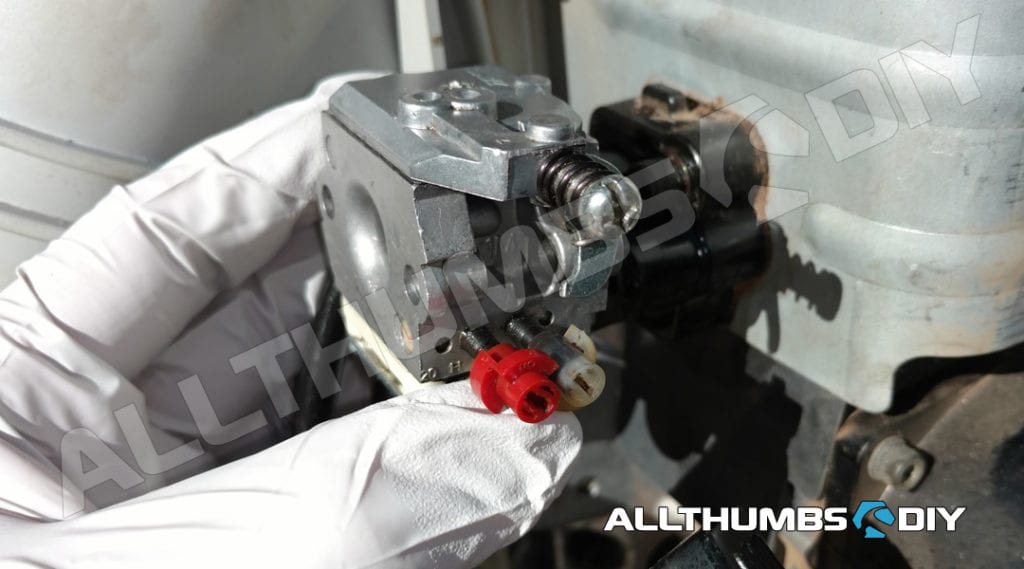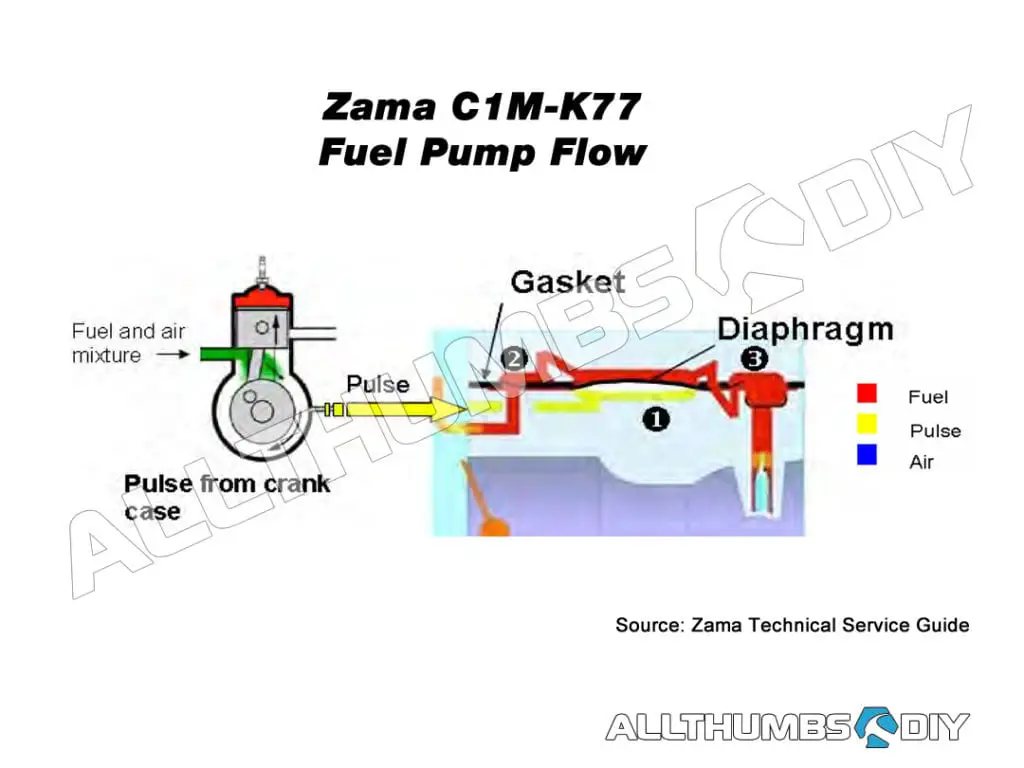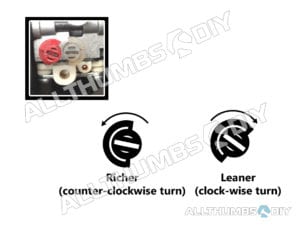
It is a good idea to adjust your Zama C1M-K77 carburetor for maximum performance after rebuilding it (or installed a new one).
YOU MAY ALSO WANT TO READ THESE POSTS:
- Basic Maintenance
- Symptoms and Repair Solutions
- Zama C1M-K77 Carburetor Rebuild
- Zama C1M-K77 Carburetor Adjustment (You are here)
- Gas in the air filter
- Non-OEM vs OEM Air Filters
- Resource Page for Echo PB-413H Backpack Leaf Blower
CARBURETOR OVERVIEW
Zama C1M-K77 carburetor is a well engineered, highly technical piece of machinery. Rather than spending hours on randomly trying different solutions, let’s go over some carburetor basics before diving into making adjustments:
- Overview of Fuel Delivery Setup
- Overview of Fuel Mixture Adjustment Screws
- Instructions – Adjusting Mixture Screws (new / rebuilt carburetor)
- Instructions – Adjusting Mixture Screws (normal operation)
OVERVIEW OF FUEL DELIVERY SETUP
Zama C1M-K77 carburetor utilizes a vacuum actuated fuel pump diaphragm that moves up and down to move the fuel mixture. Fuel diaphragm is powered by the negative and positive pulses created by the engine crankcase.
- When the piston is on the upstroke cycle, the crank case pressure becomes negative where vacuum is created. Conversely, on the down stroke a positive pressure is created;
- Each engine block has a passageway that allows this changing pulse to enter the intake manifold and carburetor through a specific hole, usually located on the backside of the carburetor, in turn this operates the pump in the carburetor;
- (1) The pulse travels from the crankcase through a drilled passage or a hose to the carburetor;
- (2) As the diaphragm moves up it expands the area in the pump chamber. This creates a vacuum, which draws fuel through a one-way inlet check valve into the chamber;
- (3) As the diaphragm moves down and compresses the area in the pump chamber the fuel is forced through the one-way outlet check valve to the inlet needle;
OVERVIEW OF FUEL MIXTURE ADJUSTMENT SCREWS
An engine will perform poorly if the fuel mixture adjustments are off, allowing too much or too little fuel to be metered. In these situations, the engine may still start, but may not idle well or reach the correct level of performance.
All Zama C1M body-type carburetors have 3 screw adjustments:
- High (HI) speed needle – controls the main jet which in turn controls the amount of fuel at full throttle; has red limiter cap and is commonly found nearest to the air filter housing;
- Low (LO) speed needle – controls the idle jet; the low speed needle has a white limiter cap and is closest to the engine; controls amount of fuel at low speed and supplementary fuel for smooth progression from idle to high speed;
- Throttle Adjustment Screw (TAS), a.k.a. butterfly adjustment or “main idle speed adjustment screw” – controls throttle opening at idle speed; screw is on the top side of the carburetor and generally much larger in size.
IMPORTANT
- DO NOT remove factory-installed limiter caps. Removing them and adjusting mixture screws may put your carburetor so far out of operational range that you will need a technician to restore it
- During HI speed mixture screw adjustment, the engine may experience a lean fuel condition.
- A prolonged wide-open throttle (WOT) with lean fuel increases the risk of severely damaging the engine
- It is very important to ensure that the engine should run less than 5 seconds at WOT when adjusting the HI speed mixture screw.
INSTRUCTIONS – ADJUSTING MIXTURE SCREWS (NEW / REBUILT ZAMA C1M-K77 CARBURETOR)
Whether you installed a new carburetor or rebuilt your existing one using a carb rebuild kit, it is a good idea to re-adjust the mixture screws for maximum performance.
-
have at least half tank full of gas
- STEP # 1 – Confirm that you have a small L beside the Idle mixture screw (white cap) and H beside the High speed mixture screw (red cap);
- STEP # 2 – When turning any of these mixture screws be careful not to over-tighten. Over-tightening can cause damage to the carburetor and/or mixture screw needles;
- Set the throttle control to medium (mid point between a turtle and rabbit logo);
- turn both mixture screws clock-wise until you can’t turn anymore; then turn them counter-clock wise 1/2 turn; this will be the initial starting point;
- Adjust TAS to touch the idle lever, then turn clock-wise for another full turn; this will push in the TAS, moving the butterfly idle lever to open more, setting the idle at fast; once the engine is warmed up and LO speed needle is set, we will lower the idle throttle;
- Press the primer bulb 2-3 times;
- Start the engine; if the engine has difficult time starting, open up the choke 1/5 way, move the throttle lever 1/2 between turtle and rabbit; do not pull more than 3 times or you risk flooding the engine;
- If the engine will still not start, wait 5 minutes; open up the choke 1/2 way, and move the throttle lever 3/4 towards the rabbit; try starting the engine;
- STEP # 3 – Start the engine and allow it to warm up for a few minutes;
- STEP # 4 – Do not try to adjust the carburetor before the engine warms up as settings change while the engine is warming up;
- STEP # 5 – Begin with the L needle, turn the needle in clockwise (lean) 1/4 turn at a time and listen to the engine;
- STEP # 6 – The engine will speed up to a certain point then start slowing down again. The point of the highest speed is called optimum. Optimum point is at the most efficient point for the engine to run;
- STEP # 7 – Once the engine is set to optimum, adjust the throttle adjustment screw (TAS; a.k.a. idle speed screw) by turning it counter-clowise (backing out) until the tip of the screw is barely rouching the idle lever; this is your standing idle speed;
- STEP # 8 – Turn the TAS counter-clockwise until the tip of the TAS is just touching the throttle lever. Gradually turn the TAS just before the clutch is engaged or ringing. This sets the proper idle speed;
- STEP # 9 – Once TAS is set, re-check the LO speed screw adjustment to confirm the optimum point as described in the previous step;
- STEP # 10 – It may be necessary to repeat these two adjustments several times to get the engine to run correct;
- STEP # 11 – The L screw may have to be opened 1/8 to 1/4 turn from this optimum point to help the engine when it is transitioning or accelerating to WOT;
- STEP # 12 – The high speed adjustment procedure is similar to the L;
- STEP # 13 – Accelerate the engine to full speed and search for the optimum point as described for the L needle (steps #5-11);
- STEP # 14 – As with the L adjustment, the H needle may be enriched a little, but no more then 1/8 to 1/4 turn from optimum point;
have engine at operating tempurature (That is warm but not overly Hot).
As a starting point, loosen (anticlockwise) Main Jet screw about half a turn, to richen mixture,so that engine will run without choke.
ADJUSTING L screw
Run engine at full speed and adjust main jet for highest smooth speed without engine missing due to mixture being too lean or rich.
Allow engine to idle and the adjust Idle Jet Screw for smoothest idle.
Idle Speed screw may have to be adjusted if idle speed is too high/low.
Sequence above may have to be repeated to get best running. If engine hesitates sometime when sudden load is applied but then picks up, try adjusting Main Jet by 1/8 to 1/4 turn richer until it handles the load without faltering.
Starting with the low speed needle turn it in “clockwise” and listen as the rpm’s go up. There will be a point that a “woowing” sound will be present, just before the engine stalls out. Now back the needle back to the 1 1/2 turn out starting point and do it again until you can distinctly hear that sound. The next time when you hear that “wooing” sound, turn the screw out about 1/4 turn from that point. The engine will now start to operate at high idle, but more smoothly.
What we just did is cause the engine to go to a lean idle state, (too little fuel) at the low end and quit. The “wooing” sound I am referring to is to give you a present indication of what a lean state in a two cycle engine will sound like. The sound is caused by too little fuel being drawn into the combustion chamber resulting in a situation where the engine can not sustain operation. The fuel is being burnt off at a rate greater than the combustion timing is calling for, and the engine starts to pulsate. By realizing this sound, you will now be able to identify when your engine is too lean at low end.
RESET IDLE SCREW
Once you have adjusted your low end needle you can now simple adjust the main idle screw to the point that the clutch disengages or is recommended by the engine manufacturer. On high performance engines with clutches I suggest that the idle be set with prop in the water, this will allow the RPM’s to be set at a higher level, which is normally necessary for engines that have been modified. If set too low a race prepared engine will tend to “load up” and stall.
SETTING HI SPEED
The high speed needle is a bit trickier… The high speed needle MUST be set under load. When an engine is put in a loaded situation they tend to lean out, therefore it is more of a guess than a science if you were to try to adjust on land. The best way to properly adjust the high speed needle is to launch the boat, get it up to temperature, a couple of laps at high speed will do, and then return to shore making small 1/8 turn increments (clockwise) starting from 1 1/2 turns out, followed by another lap or two. Do this until your boat has reached its top speed, or until you lean out… Lean out? No problem just open it a hair to where it was just before the last adjustment. All kidding aside, a lean indication on top end is indicated by a couple of things. First it is best to throttle up quickly, if the engine _ _ it’s and gets but the boat slows down and falls off pace after a lap or two you are boarder line lean. Just back it off a smidg. If it bog’s or dies when you open throttle from slow to full you are way lean, again back the needle out and give it another go. Running the engine too lean at the top end can and will cause engine damage or severely shorten an engines life span if allowed to run in this state
A rich top end is opposite, the boat will have a raspy sound at top end and not go as fast as it may be designed to go. This is not a bad thing, you may fowl a plug or two each season, but generally no real damage will come from this.
REMINDER:
- It is very important to remember about adjusting the L or H screw is not to let the engine drop much on the lean side of this point (i.e. screw in);
- Although you want to find the highest speed when turning the needle, going too far past this point may result in engine damage;
- Also, remember that the limiter caps prevent exceeding emission limits and over-rich adjustment, but not over-lean adjustment
You do not want to over-saturate the fuel/air mixture as that will cause other problems like fuel splitting back into the air filter.
If the carburetor is too far out of adjustment to run, or has been disassembled, start with turning the L and H all the way in and then open 2 turns on each needle. Then turn the TAS screw in all the way.
INSTRUCTIONS – ADJUSTING MIXTURE SCREWS (NORMAL OPERATION)
- I like to set HI speed with wide-open throttle (WOT) slightly richer to cool the plug with excess droplets of fuel mixture to minimize the risk of engine damage;
- Normal adjustment for 2 needle carburetors begins with the L needle. This adjustment controls the fuel flow to the low speed or idle circuit;
- Start the engine, run at idle for one minute;
- Complete warm up by running at full throttle for 5 minutes, operating choke twice to clear air from carburetor chambers;
- Run at idle and accelerate to check for smooth transition from idle to high speed;
- If the engine hesitates, turn LO speed screw counterclockwise 1/8th of a turn at a time until acceleration is smooth;
FINAL WORDS
I hope you found this article to be useful as you look to solve problems with your Echo PB-413 h/t backpack leaf blower with Zama C1M-K77 carburetor.
When you get a chance, can you do me a favor and sign up for my newsletter so that I can send you updates on my DIY projects?
If you have any questions, please leave a comment below.
Thanks and good luck with your DIY project!






